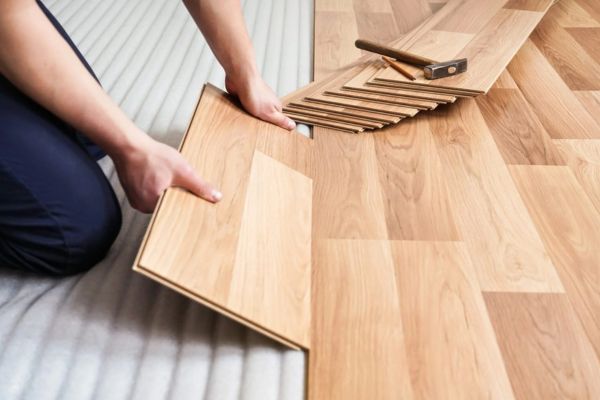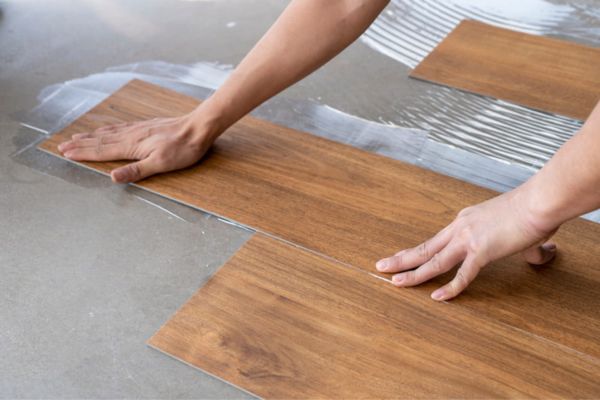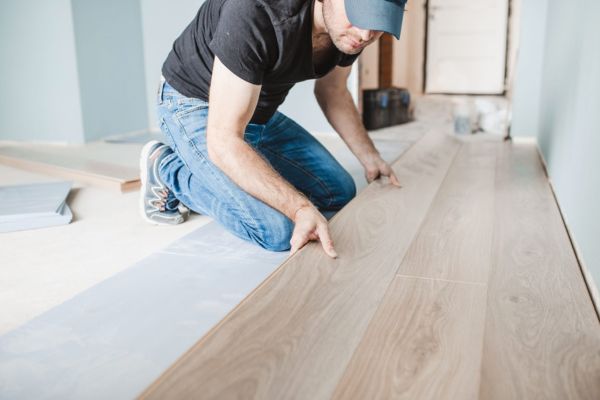Choosing the right flooring for your home is a big decision; with so many options available, it can feel overwhelming. You are not alone if you are stuck between vinyl and laminate flooring. These two materials are popular for their affordability, durability, and stylish appearance, but understanding the difference between vinyl and laminate flooring is key to making the best choice for your space.
Both options mimic the look of hardwood at a fraction of the cost, making them appealing for budget-conscious homeowners. However, their construction, water resistance, maintenance, and durability vary. Vinyl flooring is waterproof, ideal for kitchens, bathrooms, and basements. On the other hand, laminate offers a more natural wood-like feel but requires more care in moisture-prone areas.
So, which one is better? That depends on your lifestyle, budget, and where you plan to install it. Whether you are renovating a high-traffic area or upgrading your floors for long-term comfort, knowing the pros and cons of vinyl vs. laminate flooring will help you make an informed decision. In this guide, we will break down the key differences so you can confidently choose the best flooring for your home.
Key Differences Between Vinyl and Laminate Flooring
Both vinyl and laminate flooring offer budget-friendly alternatives to hardwood, but their differences impact where and how they are used. Factors like material composition, water resistance, durability, and installation determine your home’s best choice. Understanding these distinctions helps homeowners select the flooring best fits their needs and lifestyle.

Material Composition
Vinyl flooring is made from synthetic materials, primarily PVC, which makes it waterproof and highly durable. It comes in flexible sheets, rigid planks, or luxury vinyl tiles (LVT), all designed to mimic wood or stone. Laminate flooring consists of compressed wood fiber (HDF) with a photographic top layer, giving it a more natural wood-like texture but making it more susceptible to water damage.
Water Resistance
One of vinyl flooring’s biggest advantages is that it is 100% waterproof, making it perfect for moisture-prone areas like bathrooms, kitchens, and basements. Laminate, while water-resistant to an extent, has a fiberboard core that absorbs water, which can cause warping and swelling. Proper sealing and cleaning are essential to maintaining laminate in humid environments.
Durability
Vinyl flooring is highly durable and resistant to scratches, dents, and stains, making it ideal for high-traffic areas and homes with pets. Laminate is also durable but can scratch more quickly and may not hold up as well under excessive moisture. While both are long-lasting, vinyl offers better performance in homes with kids, pets, or heavy use.
Appearance and Style
Both vinyl and laminate mimic the look of hardwood, but laminate flooring offers a more realistic wood texture due to its embossed surface. Vinyl has improved significantly with modern printing technology, but it often feels smoother and less textured than laminate. Laminate may be the better choice if a high-end, authentic wood look is a priority.
Comfort and Temperature
Because of its fiberboard core, laminate flooring is typically warmer and more comfortable underfoot. It also works well with underfloor heating. Vinyl, especially thinner options, can feel colder and harder but performs well in humid environments. Some vinyl products have attached underlayment for added comfort, helping to bridge the gap in feel between the two materials.
Installation
Both vinyl and laminate flooring are available in click-lock, floating floor systems, making them DIY-friendly. Laminate typically requires an underlayment for cushioning and moisture control, while some vinyl planks have built-in backing layers. Vinyl sheets and glue-down vinyl may require professional installation, whereas laminate’s tongue-and-groove design is more manageable for beginners.
Cost
Both options are affordable compared to hardwood, but vinyl flooring generally has a broader price range based on thickness and quality. Basic vinyl is very budget-friendly, while luxury vinyl plank (LVP) can cost more than laminate. Laminate offers a mid-range price point, balancing realistic wood appearance and affordability without the high cost of natural hardwood.
Pros and Cons of Vinyl Flooring

Determining the difference between vinyl and laminate flooring comes down to knowing what each type has to offer. Vinyl flooring is popular for homeowners looking for a durable, waterproof, and low-maintenance option. While it offers excellent performance in high-moisture areas and high-traffic spaces, it has some drawbacks. Understanding the advantages and limitations of vinyl flooring helps determine if it is the right fit for your home.
Pros
One of vinyl flooring’s most significant advantages is that it is 100% waterproof, making it ideal for kitchens, bathrooms, basements, and laundry rooms. Spills, moisture, and humidity will not cause swelling or warping. Vinyl flooring is also easy to clean and maintain, requiring only regular sweeping and mopping.
Vinyl flooring resists stains, scratches, and dents, making it a long-lasting choice for busy households with kids and pets. With technological advancements, luxury vinyl planks (LVP) provide a stylish appearance while maintaining exceptional durability in high-moisture environments.
Cons
Despite its durability, vinyl flooring lacks the realistic texture and depth of laminate. While it visually mimics wood and stone, the surface often feels smoother and less natural. Additionally, vinyl flooring can feel cold and hard underfoot, especially without a built-in underlayment. Thinner vinyl planks may also produce a hollow sound when walked on, reducing comfort.
Some homeowners opt for premium vinyl with padded backing or additional underlayment to improve warmth and comfort, but this increases the overall cost. While durable, vinyl flooring may not provide the same warmth and authenticity as real hardwood or laminate.
Pros and Cons of Laminate Flooring
Understanding the difference between vinyl and laminate flooring is vital to ensuring you choose the right option for your project. Laminate flooring is a versatile and budget-friendly option that closely mimics real hardwood. It offers warmth, comfort, and a natural wood-like appearance without the high cost of solid wood. However, while it performs well in most rooms, it has some drawbacks, especially in high-moisture areas. Understanding its pros and cons helps homeowners make an informed decision.

Pros
Laminate flooring is known for its realistic wood textures, making it one of the most visually appealing alternatives to hardwood. The embossed surface enhances its natural grain look, providing an authentic feel underfoot. Unlike vinyl, laminate has a warmer and more comfortable surface, especially in colder climates.
It is also cost-effective, offering a high-end appearance at a lower price point. With various styles and finishes available, laminate provides an elegant flooring solution for homeowners on a budget who still want the beauty of wood without the expense of solid hardwood.
Cons
Although laminate flooring is water-resistant, it is not fully waterproof, making it less suitable for bathrooms, basements, or moisture-prone areas. If water seeps into the seams, the fiberboard core can swell and warp, causing irreversible damage.
Unlike vinyl, laminate cannot withstand prolonged exposure to humidity or spills, requiring immediate cleanup to prevent issues. Over time, repeated exposure to moisture may lead to buckling, lifting, or soft spots in the flooring. While durable in dry areas, laminate’s vulnerability to moisture limits its use in certain parts of the home.
Which Should You Choose: Vinyl or Laminate Flooring?
Both vinyl and laminate flooring have advantages, but the best choice depends on your lifestyle, budget, and where you plan to install it. Vinyl is ideal for moisture-prone areas, while laminate provides a more natural wood feel in drier spaces. Understanding when to choose each option ensures you make the right decision for your home.
Choose Vinyl Flooring If:
Vinyl flooring is the best option if you need a fully waterproof surface that can handle spills, humidity, and moisture-prone areas like bathrooms, basements, and kitchens. It’s also highly durable and resistant to scratches and dents, making it ideal for homes with pets, children, or heavy foot traffic. Vinyl is also low-maintenance, requiring only regular sweeping and mopping. If you want long-lasting, hassle-free flooring that performs well in all conditions, vinyl is a great choice. Modern vinyl options also come in stylish designs that closely resemble wood and stone.
Choose Laminate Flooring If:
Laminate flooring is the right choice if you prefer a more natural wood look and texture at a budget-friendly price. It works well in living rooms, bedrooms, and dry areas with minimal water exposure. Laminate is also warmer and more comfortable underfoot than vinyl, making it a great option for homes in colder climates. If aesthetics matter most and you want an affordable hardwood alternative, laminate is a solid option. However, it requires careful maintenance in moisture-prone areas, as standing water can damage its fiberboard core.
Ready to Upgrade Your Flooring?
At Murfreesboro Flooring, we believe that quality and value should go hand in hand. With over 20 years of experience, we specialize in expert flooring installation and repairs, ensuring every project meets the highest standards. Whether you are upgrading to vinyl, laminate, hardwood, or tile, our skilled team is committed to delivering exceptional craftsmanship and customer service.
From consultation to installation, we listen to your needs and provide solutions that blend durability, style, and affordability. If you are ready for a seamless, professional flooring upgrade, trust the specialists at Murfreesboro Flooring. Contact us today for a consultation, and let’s bring your vision to life!
Conclusion
Choosing between vinyl and laminate flooring depends on your home’s needs, lifestyle, and budget. Vinyl is the best choice for waterproof durability, making it ideal for high-moisture areas like kitchens and bathrooms. Laminate, on the other hand, offers a more natural wood feel and works best in dry areas like bedrooms and living spaces.
Both options provide affordable, stylish alternatives to hardwood, but understanding their differences helps you make the right decision. If you are ready to upgrade your floors with expert installation and top-quality materials, Murfreesboro Flooring is here to help. Contact us today to get started on your flooring project and learn the difference between vinyl and laminate flooring!

